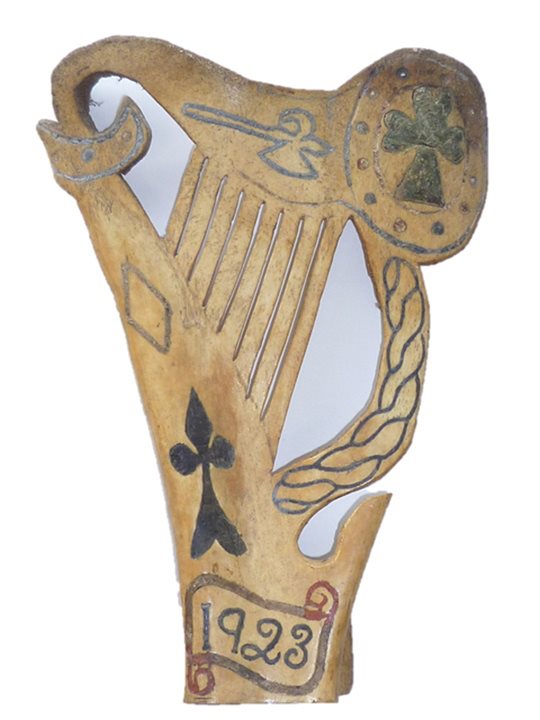1923
Irish Republican POW Bone Carvings
Carved by Irish Republican POWs interned in the Curragh, Co. Kildare, 1923.
By Noel CampbellDescription
Each of these two harps was carved from the shoulder blades of an animal. They measure 29cm high and 19cm and 20cm wide, respectively. The front of each harp is decorated. A shamrock and the inscription ‘Tintown No.3’ form part of one harp’s décor while the second harp has a pike, a shamrock and the date ‘1923’ carved on its front. The backs of both harps were left unornamented.
Who carved these harps?
Following the outbreak of Irish Civil War in June 1922 the Provisional Government required prisons and camps to house prisoners interned throughout the country. A Prisoners Department was established in the Office of the Adjutant General while military personnel took over the operation of several prisons and established internment camps. These prisons and camps included Tintown internment camps in the Curragh.
A body of prison art came from the camps including greeting cards sent home to family members. Internees (possibly only one in this case) held in Tintown No.3 camp in 1923 carved these harps.

Conditions at Tintown
The production of prison art in Tintown points to a tolerant atmosphere in the camps. Issues surrounding Tintown were frequently debated in Dáil Éireann, Ireland’s Lower House of Parliament. In June 1923, a Tintown internee wrote: “This is a fine healthy place, I was never in so good a form before.” From the same camp another prisoner wrote: “We had a great day yesterday, we had all sorts of sports that you could mention, you could not have a better day outside, and we do have a dance now every evening—the best of gas.” These letters were brought to the attention of the camps’ detractors in the Dáil by the Free State Minister for Defence, General Richard Mulcahy TD.
Tintown did hold men bent on overthrowing the new Free State but it also held men accused of committing innocuous acts. The plight of the latter was also raised in the Dáil. The relative isolation of the Curragh camp meant it continued to be used for internment during the Emergency (the period of the Second World War, 1939-46) and into the 1950s.
Learn more
These harp carvings are held in storage in the Museum of Country Life, Castlebar and are not on public display.
You can find more information in the following:
Coogan, Tim Pat & Morrison, George, 1998. The Irish Civil War, London: Weidenfeld & Nicolson
Durney, James, 2011. The Civil War in Kildare, Cork: Mercier Press
Location:
Irish Republican POW Bone Carvings is located at:
In Storage
Previous artefact:
Next artefact:
Jane Stephens, 1879-1959: Naturalist and Museum Worker
